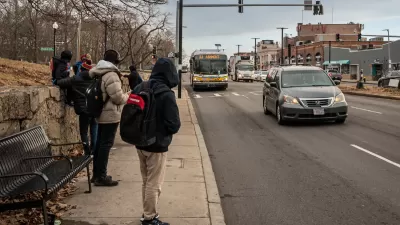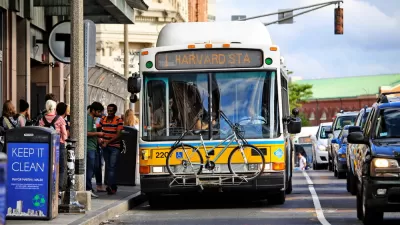Gold Standard is the term used by the Institute for Transportation & Development Policy to define world-class BRT service. A recently released ITDP study, underwritten by the Barr Foundation, argues for more Gold Standard service.
"The report argues that the city should be pushing for the 'gold standard' of bus rapid transit," writes Nicole Dungca of The Boston Globe. "A group of mass transit specialists and community activists convened by the [Boston-based] Barr Foundation, "want that to be a reality for Greater Boston."
The Silver Line operates on an exclusive lane for part of its route, but more is needed to attain Gold Standard status. [More on that line's shortcomings below.] "The elements of bus rapid transit also include allowing buses to have shorter waiting times at intersections to cut commute times, and elevated platforms so riders can board quickly."
The system is prominent in dozens of cities, such as Cleveland, Los Angeles, Mexico City, and Rio de Janeiro, according to the report. Nearly 100 corridors with bus rapid transit operate in 62 cities worldwide.
However, no U.S. BRT system "has been certified by experts as the 'gold standard,'" writes Dungca. "That distinction has gone to only a few cities, such as Belo Horizonte, Brazil, and Lima, Peru.
Cost effective transit investment
“For a number of high-demand corridors, BRT could provide fast, comfortable, reliable service at lower cost than alternatives,” the report said. “Investment in BRT elsewhere in the United States has shown that on average, BRT can be seven times more affordable than light rail, per mile.”
Background - from report's executive summary [PDF]:
To better understand whether and where BRT could work in the region, the Barr Foundation convened the Greater Boston BRT Study Group [in 2013]. Made up of diverse stakeholders and transit experts from across the city, the BRT Study Group partnered with the Institute for Transportation & Development Policy (ITDP), an internationally respected organization, to investigate the possibilities for implementing BRT throughout the metropolitan area.
According to the ITDP blog, they "analyze(d) a number of potential corridors in which BRT could reduce congestion on the T, serve underserved communities or groups, provide more direct connections between neighborhoods, and serve planned future development."
About the existing Silver Line service:
From Wikipedia: "Speed and schedule performance have disappointed some transit advocates and the Silver Line routes fall far short of the minimum BRT Standard promulgated by the Institute for Transportation and Development Policy (ITDP). Some sections have an exclusive right-of-way, but other sections are bogged down by street running in congested mixed traffic."
Hat tip to American Association of State Highway and Transportation Officials' (AASHTO) "Daily Transportation Update", June 22.
FULL STORY: Area could benefit from more bus rapid transit, report says

Americans May Be Stuck — But Why?
Americans are moving a lot less than they once did, and that is a problem. While Yoni Applebaum, in his highly-publicized article Stuck, gets the reasons badly wrong, it's still important to ask: why are we moving so much less than before?

Using Old Oil and Gas Wells for Green Energy Storage
Penn State researchers have found that repurposing abandoned oil and gas wells for geothermal-assisted compressed-air energy storage can boost efficiency, reduce environmental risks, and support clean energy and job transitions.

Placekeeping: Setting a New Precedent for City Planners
How a preservation-based approach to redevelopment and urban design can prevent displacement and honor legacy communities.

San Francisco’s Muni Ridership Grew in 2024
The system saw its highest ridership since before the Covid-19 pandemic, but faces a severe budget shortage in the coming year.

Colorado Lawmakers Move to Protect BRT Funding
In the face of potential federal funding cuts, CDOT leaders reasserted their commitment to planned bus rapid transit projects.

Safe Streets Funding in Jeopardy
The Trump administration is specifically targeting bike infrastructure and other road safety projects in its funding cuts.
Urban Design for Planners 1: Software Tools
This six-course series explores essential urban design concepts using open source software and equips planners with the tools they need to participate fully in the urban design process.
Planning for Universal Design
Learn the tools for implementing Universal Design in planning regulations.
Heyer Gruel & Associates PA
City of Moreno Valley
Institute for Housing and Urban Development Studies (IHS)
City of Grandview
Harvard GSD Executive Education
Salt Lake City
NYU Wagner Graduate School of Public Service
City of Cambridge, Maryland





























